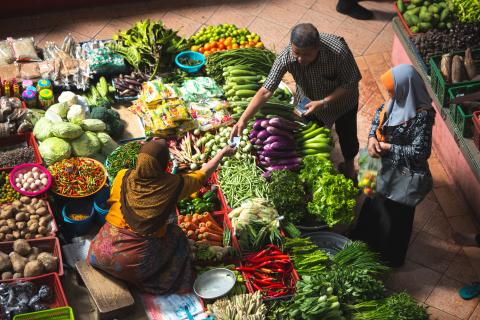Monitoring the cost and affordability of a healthy diet within countries
This is a summary of the following paper: Herforth AW, Gilbert R, Sokourenko K et al (2025) Monitoring the cost and affordability of a healthy diet within countries: Building systems in Ethiopia, Ghana, Malawi, Nigeria, Pakistan, Tanzania, and Viet Nam. Current Developments in Nutrition, 8(10), 104441. https://doi.org/10.1016/j.cdnut.2024.104441
The ‘cost and affordability of a healthy diet’ (CoAHD) is an indicator of economic access to a healthy diet, defined as a diet adhering to food-based dietary guidelines (FBDG). The ‘cost of a healthy diet’ (CoHD) is determined using retail food price data (often routinely collected by governments) to identify the least-cost items in each food group recommended for daily consumption. The ‘affordability’ of this diet is then calculated by comparing the CoHD to household income available for food. The percentage and number of people who cannot afford a healthy diet can be estimated at national or subnational level.
The paper describes the methods, software tools, and data sources used to calculate these indicators. For the CoHD, three types of data are needed: retail food prices, food composition data, and quantified dietary guidelines. For the CoAHD, three additional data sources are required: income data, an estimate of the cost of (or expenditure on) non-food items, and the total population.
Over an eight-year period, stakeholder workshops and meetings were held in Ethiopia, Ghana, Malawi, Nigeria, Pakistan, Tanzania, and Viet Nam using the CoAHD indicator. Learnings from each country are summarised including the agencies involved, partnerships and collaborations, data sources, healthy diet standards, policy applications, and dissemination platforms.
Four countries used their national FBDG as the healthy diet standard. The remaining three countries did not have quantified national guidelines and used the Healthy Diet Basket (HDB), which summarises average recommendations across many countries.
Despite following a standardised calculation process, the CoAHD differs depending on the data sources and standards used. For example, in Pakistan four calculations were made to compare subnational and global data sources and standards. The CoHD was calculated twice: first using Pakistan’s FBDG and second using the HDB. Affordability was also calculated twice, by using non-food expenditures from the Pakistan Household Integrated Economic Survey and by allocating 52% of income for food (aligned with methods used in global monitoring in 2024 and 2023 respectively). The resulting CoAHD values ranged from 56% to 77% of people who could not afford a healthy diet in 2021.
The authors suggest three main reasons why the CoAHD will differ between national and global monitoring systems:
- Food price data: subnational price lists include more locally important, least-cost items, thereby generating lower estimates for the CoHD.
- Healthy diet standard: costs vary depending on the food groups recommended, with animal-source foods typically being more expensive than plant-source foods.
- Income data and affordability standard: the share of expenditure on food varies considerably between and within countries.
The paper concludes that closer alignment between national and global monitoring may be achieved if updated national food price data are integrated into global tracking systems.


